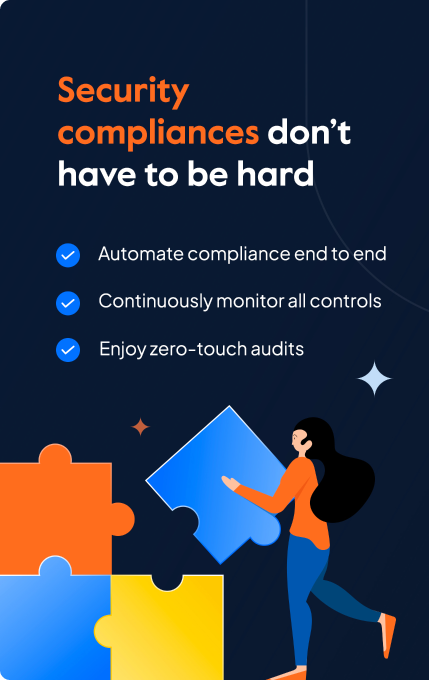An Expert Guide To GDPR Data Mapping
Vimal Mohan
Apr 03, 2024
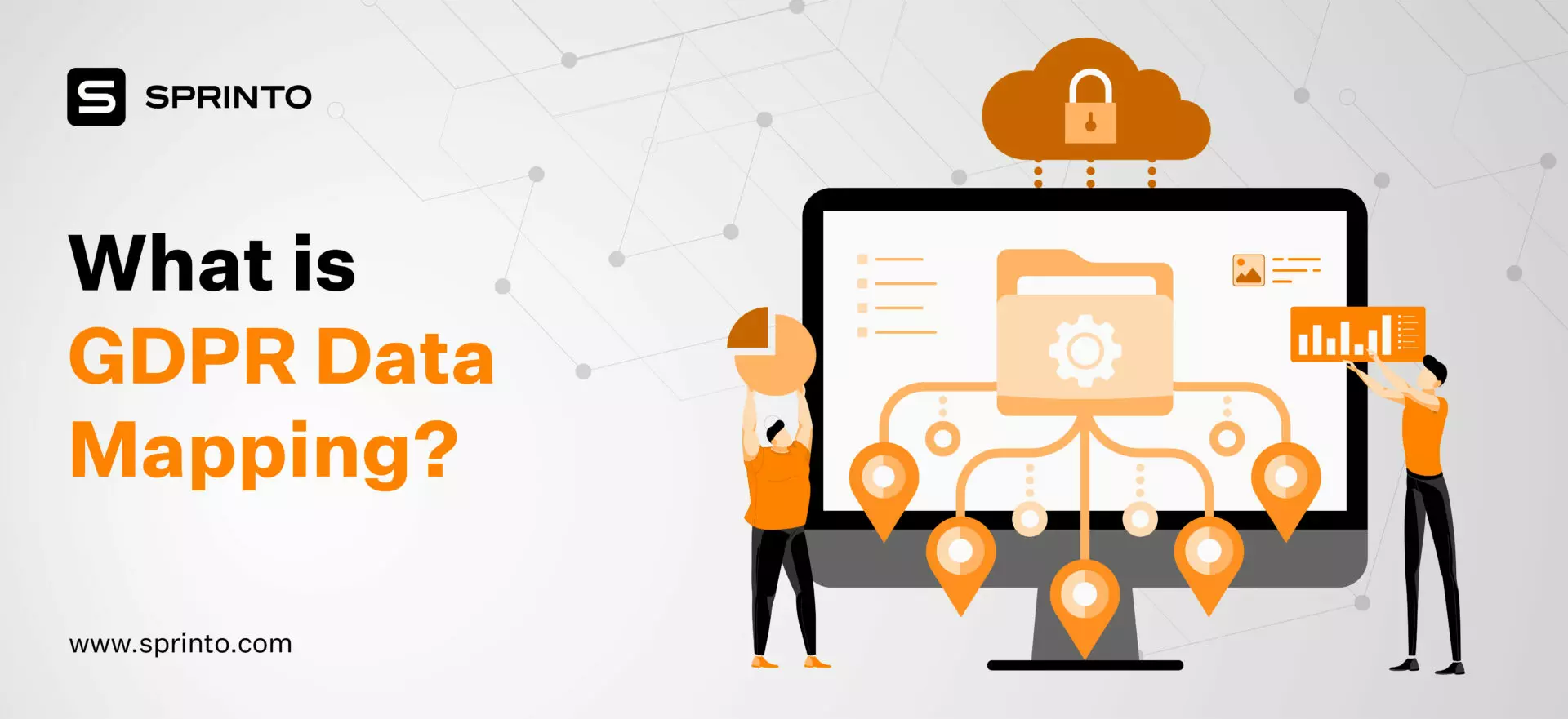
GDPR Data Mapping is the process of indexing and recording how your business collects data, stores data, and uses it internally and on external channels. it gives organizations a clear picture of their data, enabling them to identify and mitigate risks, such as data breaches, unauthorized access, and data loss.
A data map essentially is a road map of a data subject’s data through your internal systems until it is transferred to an external unit.
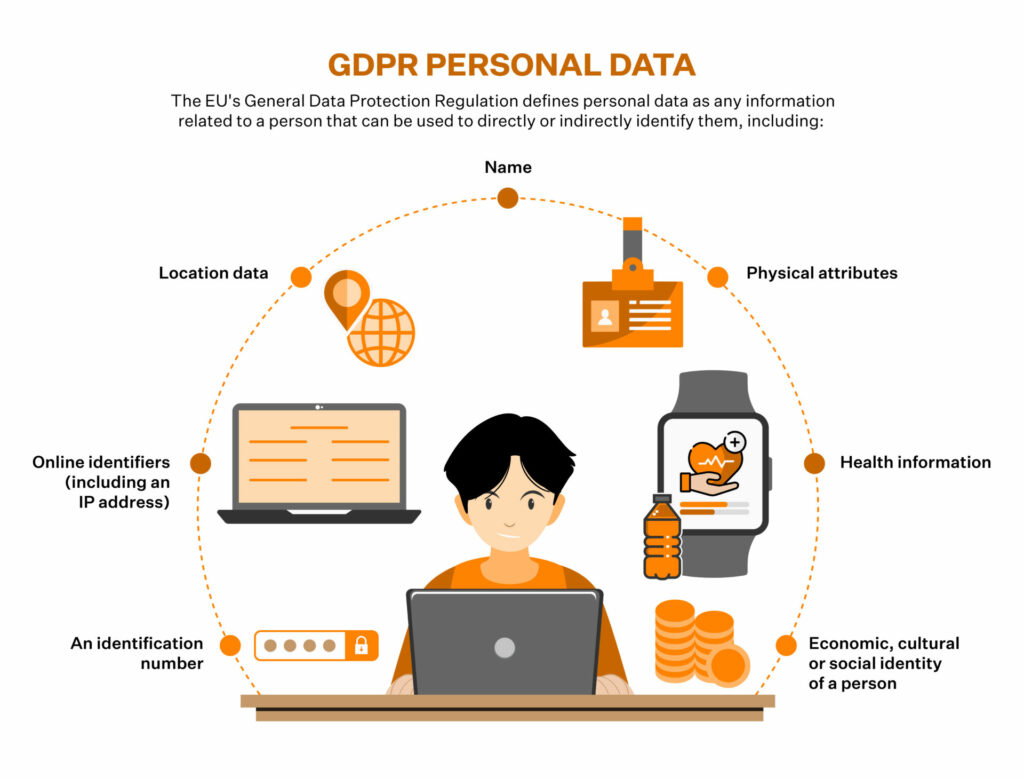
Data mapping for GDPR, when executed correctly, helps the organization monitor their internal processes and create a security-first environment to protect user data by identifying areas of improvement and eliminating processes and systems that are vulnerable… In addition, this activity reinforces the security posture while unmasking future vulnerabilities that could lead to a data breach.
A valid data map of how they process personal data must be presented for any business to comply with Article 30 and Article 36 of GDPR.
How to Conduct Data Mapping GDPR for Privacy Compliance
The Data mapping GDPR exercise is thorough and can save you a lot of time and effort in the long run when done right on the first attempt.
A good GDPR data map is generally put into effect in seven stages:
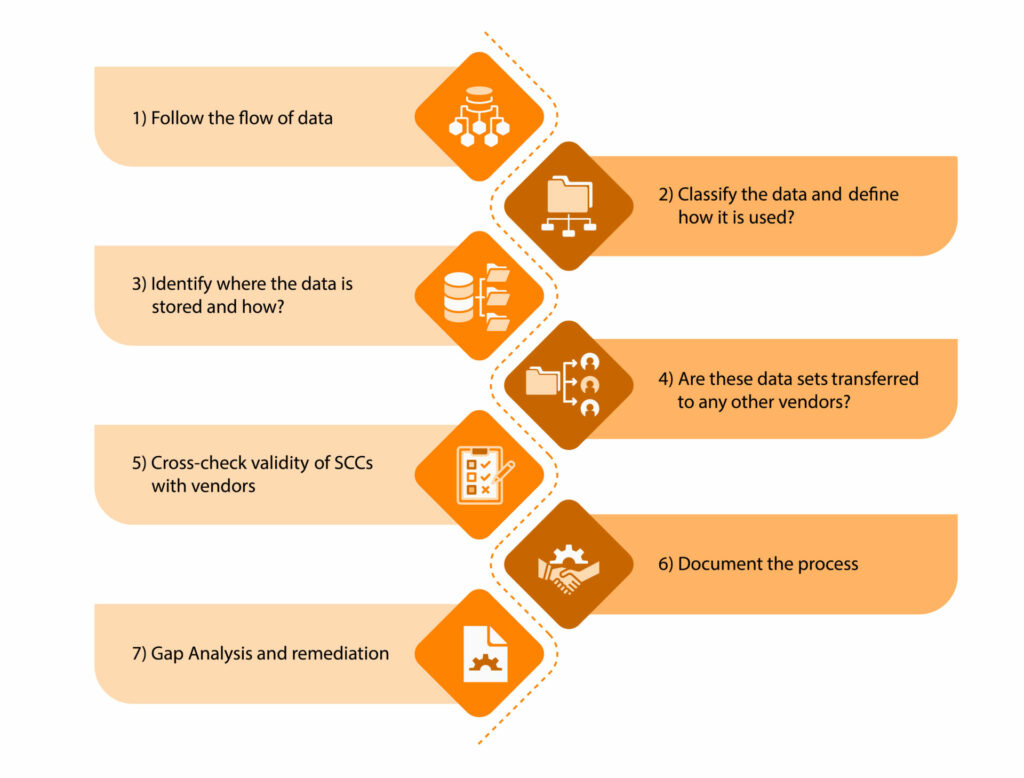
Follow the data:
As the entity in charge of ensuring effective GDPR certification for your business, you must know where your company collects data. Once it reaches your business environment, the next step is to realize its natural path.
Identify all the teams that have access to the said data and define how that data is being used across the company.
A good reference check at this stage would be to double-check if your business is using that data for the intended purpose as declared in your privacy policy, or is that data getting reused elsewhere too?
Automate the evidence-collection process with the help of Sprinto. Talk to our experts
Classify the Data and Define How It’s Used Internally
Studying the data sets and classifying them periodically is an excellent way to monitor the data your business transacts with. This also acts as a good check if you ever receive data sets that are not similar to your normal usage parameters.
Analyzing the data allows you to get a detailed insight into all the personal data you are holding.
As an organization, you should be able to produce evidence that you procure data legally. And, that you are using the data sets in the same manner you declared you would on your website’s privacy policy page.
Be proactive towards being ‘private by design or privacy by default.
Identify where the Data is Stored and How?
An effective data mapping strategy will help you fortify the storage units where any physical or digital forms of personal data are stored. The data map should specify the format in which the data is being held.
If it’s in physical form, is it encrypted on storage devices and not on easy-access paper units?
If it is saved electronically, details of the virtual locations should be stored.
For example, is it on a CSPs server, is it on a local server in the same city, or is it in a shared storage unit from a local cloud storage vendor?
Your data map should also include information on how long each data set is stored within the business before they are transferred or revoked from use.
Make sure all your data is stored as per the GDPR guidelines. Get our expert’s help
Is the Data Transferred to any other Vendor?
In your data map, you should be able to isolate the nodes from which data from your organization is transferred to other vendors or businesses.
These nodes in your data map could be marked as areas susceptible to an incident. This will enable you with the information required to fortify the security posture in the vulnerable zones.
Cross-check Validity of SCCs:
Whenever data leaves your organization in the form of a data transfer, it is imperative to ensure that the business/entity you are transferring it to is within the European Economic Area (EEA).
In instances when they are outside the EU’s purview, the transaction will be considered legal only if they are GDPR compliant and have a valid Standard Contractual Clause (SCC) signed with your organization.
Always ensure that no SCC gets expired. When an SCC is nearing its expiration, your business should renew its SCC with said vendor or cease business transactions. This saves you from non-compliance and hefty GDPR non-compliance fines.
Follow this link to know more about SCCs
Gap Analysis and Remediation:
GDPR data mapping enables your business to keenly observe the moving parts of your business and also notice the dormant ones.
The data map will give you a bird’s eye view of the existing gaps in your compliance posture by highlighting the processes that are not 100% compliant, unaccounted data loss, unaccounted physical storage units from yesteryears, and more.
By continuously performing a gap analysis and remediating the risks, you are better equipped to prevent a bad-actor instance that could lead to a breach.
Automate GDPR compliance requirements with the help of Sprinto. Talk to our experts
Document The Process
Documentation is one of the crucial aspects of GDPR compliance. With proper documentation of your GDPR data mapping efforts, your business can quickly produce evidence of the security systems in place and adherence to continuous compliance in an unfortunate event of a breach.
A breach warrants an investigation from a supervisory authority, and your documentation for GDPR data mapping could significantly reduce or eliminate the fines that could come your way.
Also check out: GDPR article 30
Manual vs Automated Data Mapping for GDPR
Data Mapping is strenuous, and the chances of getting it right on the first attempt are low, especially if you do it in-house manually.
A data map is mandated by Article 30, Article 25, Article 6, Article 28, and Article 35
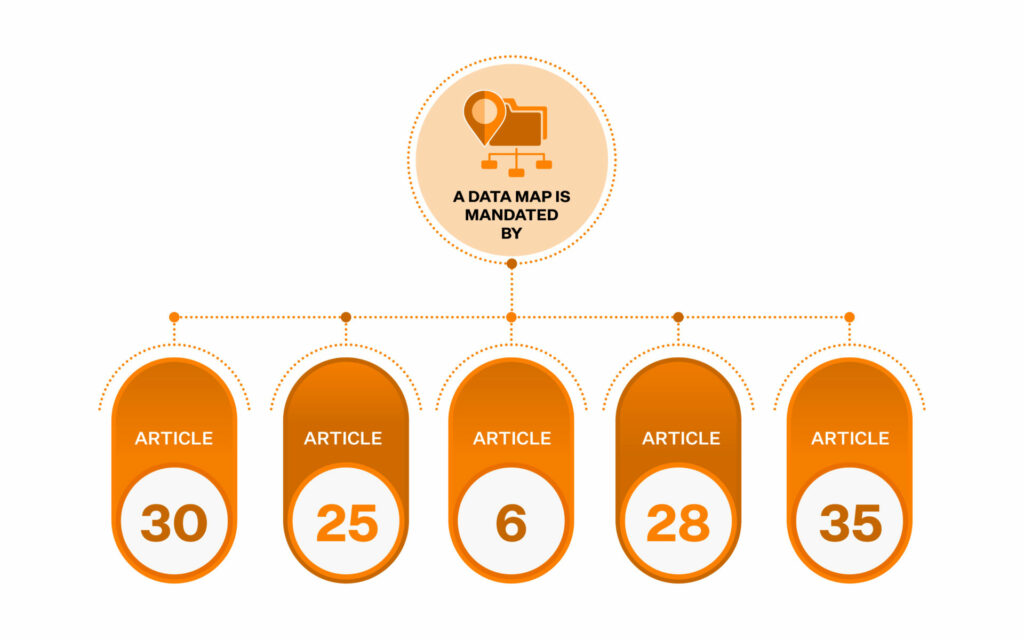
There is no one-size-fits-all solution to developing data maps. It could be as basic as a PowerPoint presentation with a clear representation of all the attributes of the internal processes and the flow of data, or it could be a complex spreadsheet with multiple tabs.
Manual data mapping was recommended by the experts when the overall data volumes were low, the number of nodes data sets passed through were few, and there were virtually no blind spots in the data flow.
Organizations that deal with large volumes of personal data generally onboard a Data Processing Officer (DPO). The DPO onboards an automated data mapping vendor to streamline GDPR data processes and eliminate blind spots in their periodic reports.
In today’s cloud-based environment, it is logical to automate the Data Mapping process given the volume of cloud assets and integrations even a 10-member cloud business onboards.
Important note:
When a supervisory authority from the GDPR demands proof of compliance (in this case, Data Maps), the map's accuracy and efficiency could help you prevent/minimize fines that could come your way. In addition, an accurate data map proves that your business has periodically audited its systems to ensure their continued compliance.
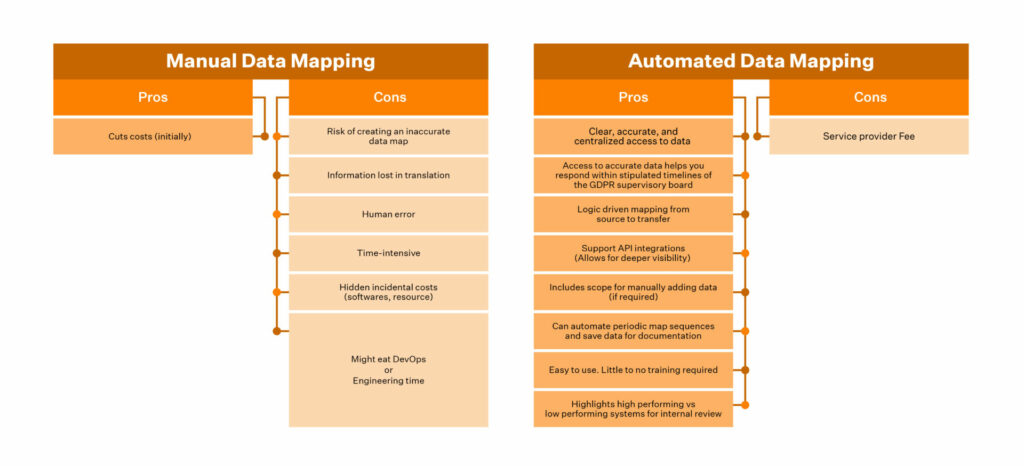
| Pros of Manual GDPR Data Mapping | Cons of Manual GDPR Data Mapping |
| Cuts costs (initially) | Risk of creating an inaccurate data map |
| Information lost in translation | |
| Human error | |
| Timeintensive | |
| Hidden incidental costs (software, resource) | |
| Might eat DevOps or Engineering time |
Reduce human errors by automating GDPR compliance. Talk to us to know more
Automated GDPR Data Mapping
Sprinto is purpose-built to help companies become and remain GDPR compliant by automating critical tasks (where human error could have a catastrophic impact on the business) and mundane administrative tasks.
We help organizations not just achieve an accurate data map but go the extra mile and help them maintain an accurate Record Of Processing Activities (ROPA).
ROPA is essentially a snapshot of the organization’s systems and processes.
With ROPAs, we help organizations build GDPR-compliant processes to ensure maximum adherence to compliance at all times.
What Constitutes a GDPR Data Mapping Template?
In essence, every GDPR data mapping template used will be per the nature of the organization’s business. That said, every data map consists of these common things:
- Data Type: Every data map should include detailed insights on the type of data the business receives, stores, processes, or transfers. Every attribute of the data set should be documented.
- Sensitive Data Classification: Every data set you receive from legal sources should be scanned to verify if any attribute of the data set could be used to trace it back to the source.
- Specify the Source: As a business, you must list all your data collection sources. For example, if you are using forms on your website or are relying on external sources to procure data, your GDPR data map should include this information.
- Intention: Under GDPR, businesses can only source or collect data for limited purposes. Therefore, your GDPR map should clearly state the purpose of your data collection.
- Data Storage Period: Under GDPR, you cannot store user data for extended periods, depending on its classification. Data Maps can be integrated to your internal systems to alert you of instances where the data stored could go over the allowed threshold, thereby enabling you to prevent a breach.
- Storage: Your data map should include your business’s physical and virtual storage locations. When using multiple storage locations, including details on each unit is recommended.
- Track your Data: Business requirements will have you transfer data legally to entities inside and outside the business. Keeping a close track of where the data is sent helps you create a data map of all your outgoing data instances for future reference.
- Data Transfer to Vendors outside EEA: Suppose you are legally transferring data to vendors outside the EU region, your data map must then contain all the legal information required to prove your vendor’s GDPR compliance and use of SCCs to ensure data integrity.
What Is the Purpose of Data Flow Mapping in GDPR?
Data flow mapping in GDPR serves two purposes:
1) To Be Compliant With Article 30 of GDPR
Article 30 of GDPR requires businesses to have a ROPA. Data mapping is a subset of ROPA that companies can leverage to become compliant.
2) To Increase Visibility
GDPR data mapping helps organizations streamline their data consumption and storage processes while analyzing critical data to evaluate its secure zones and vulnerabilities. This analytical approach allows organizations to utilize their resources to maximize efficiency and security.
It acts as an organization’s single data source to represent the entire structure with specific details on each function and nodes within.
A good data mapping software for GDPR helps increase visibility into how the business collects, stores, and processes user data. This singular view of distributed resources helps spot gray areas, recommend process improvements, and identify potential risks the business could encounter.
Data mapping yields the best results when conducted in regular intervals. Data Mapping helps organizations consistently monitor and document their processes and systems designed to ensure continued efficiency to help them remain GDPR compliant.
This documentation also doubles up as evidence when a business is asked to provide proof of continuous compliance.
Are you finding it difficult to map your data mapping processes? Talk to our experts today to know how Sprinto goes the extra mile in streamlining your compliance efforts.
FAQ
Is it mandatory to have a data map to be GDPR compliant?
To be GDPR compliant, maintaining a data map is not mandated. However, a data map is heavily depended upon in for other GDPR compliance activities like maintaining an accurate ROPA, risk detection, and processing privacy instances.
What are the 7 steps of data mapping?
The seven steps of data mapping are:
- Follow the flow of data
- Classify the data and define how it is used?
- Identify where the data is stored and how?
- Are these data sets transferred to any other vendors?
- Cross check validity of SCCs
- Document the process
- Gap analysis and remediation
Why is data mapping important?
Data mapping ensures that data flow from one business unit to another is thoroughly mapped and changes made along the way are documented. Data mapping ensures that there is standardization followed across business units and thus reducing the occurrences of errors.
Vimal Mohan
Vimal is a Content Lead at Sprinto who masterfully simplifies the world of compliance for every day folks. When not decoding complex framework requirements and compliance speak, you can find him at the local MMA dojo, exploring trails on his cycle, or hiking. He blends regulatory wisdom with an adventurous spirit, navigating both worlds with effortless expertise
Grow fearless, evolve into a top 1% CISO
Strategy, tools, and tactics to help you become a better security leader
Found this interesting?
Share it with your friends
Get a wingman for
your next audit.
Schedule a personalized demo and scale business

Sprinto: Your growth superpower
Use Sprinto to centralize security compliance management – so nothing
gets in the way of your moving up and winning big.



